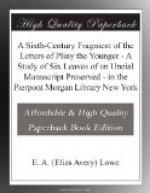As is often the case, the leading manuscript authorities are only inadequately represented in the early editions. The Editio Princeps (p) of 1471 was based on a manuscript of the Guarino recension. A Roman editor in 1474 added part of Book VIII, putting it at the end and calling it Book IX; he acquired this new material, along with various readings in the other books, from some manuscript of Class II that may have come down from the north. Three editors, called {sigma} by Keil—Pomponius Laetus 1490, Beroaldus 1498, and Catanaeus 1506—took r as a basis; but Laetus had another and a better representative of the same type of text as that from which r had drawn, and he likewise made use of V. With the help of these new sources the {sigma} editors polished away a large number of the gross blunders of p and r, and added a sometimes unnecessary brilliance of emendation. Avantius’s edition of part of Book X in 1502 was appropriated by Beroaldus in the same year and by Catanaeus in 1506; these latter editors had no new sources at their disposal. No wonder that the Parisinus seemed a godsend to Aldus. The only known ancient manuscripts whose readings had been utilized in the editions preceding his own were F and V, both incomplete representatives of Classes I and II. The manuscripts discovered by the Roman editor and Laetus were of great help at the time, but we have no certain evidence of their age. B and M were not accessible.[31] Now, besides the transcript of Giocondo and his other six volumes, whatever these may have been, Aldus had the ancient codex itself with all ten books complete. Everybody admits that the Parisinus, as shown by the readings of Aldus, is clearly associated with the manuscripts of Class I. Its contents corroborate the evidence of the title in B, which indicates descent from some codex containing ten books.
[Footnote 31: C.P. X, p. 20.]
[Sidenote: _{Pi} a member of Class I_]
Now nothing is plainer than that _{Pi}_ is a member of Class I, as it agrees with BF in the following errors, or what are regarded by Keil as errors. I consider the text of the Letters and not their superscriptions. 60, 15 duplicia] MVD duplicata _{Pi}BFGa_; 61, 12 confusa adhuc] MV adhuc confusa _{Pi}BFGa_; 62, 6 doctissime] MV doctissima _{Pi}BFDa_ et doctissima G; 62, 16 nec adficitur] MVD et adficitur _{Pi}BFGa_; 62, 23 quorum] MVDGa qui horum _{Pi}BF_; 63, 22 teque et] MVDG teque _{Pi}BFa_; 64, 3 proferenda] Doxa conferenda BFu CONFERANDA _{Pi}_ (MV lack an extensive passage here); 65, 11 alii quidam minores sed tamen numeri] DG alii quidam minores sed tam innumeri MV alii quidem minoris sed tamen numeri _{Pi}BFa_; 65, 12 voluntariis accusationibus] M (uoluntaris) D voluntariis om. V accusationibus uoluntariis _{Pi}BFGa_; 65, 15 superiore] MVD priore _{Pi}BFGa_; 65, 24 iam] MVDG om. _{Pi}BFa._




